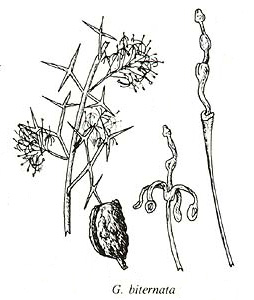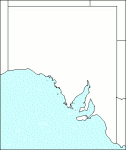Family: Proteaceae
Grevillea biternata
Citation:
Meissner in Lehm., Pl. Preiss. 1:549 (1845).
Synonymy: Not Applicable Common name: None
Description:
Shrub to 1.2 m high, suckering; branchlets persistently appressed-pubescent; leaves rigid, divaricate, 3-5.5 cm long, glabrous, long-petiolate, divided into 3 primary segments, these often divided again into 2 or 3 segments, final segments thus 3-9, needle-like, 0.5-4 cm X c. 0.7 mm, with an obscure sometimes sericeous groove on either side of the prominent midrib below, slenderly mucronate.
Racemes simple, axillary, shorter than the leaves, with 8 (by bud drop)-30 white glabrous flowers; rhachis 0.7-2 cm long, with a few scattered hairs, sometimes several in panicle, the common rhachis appressed-pubescent; pedicel 7-9 mm long; toms horizontal to slightly oblique; perianth 3-3.5 mm long, with a slender tube terminating in a large erect globular limb, splitting into 4 free segments; gland small, semi-annular; gynophore slender, long, becoming bent at anthesis; ovary globular; style obliquely inserted, erect, as long as the gynophore, 1.7-2.2 mm long, constricted at the base, swollen for most part, constricted below the pollen-presenter which is an erect cone with a horizontal discoid basal flange.
Fruit ellipsoid, 7-12 mm long, coarsely muricate-rugose, obliquely or laterally inserted on a long stipe, with an erect laterally inserted persistent style, glabrous; seed becoming flat, elliptic, brown-black, surrounded by a very narrow pale-yellow wing.

| twig, flower, pistil and gynophore and fruit
|
Image source: fig. 69b in Jessop J.P. & Toelken H.R. (Ed.) 1986. Flora of South Australia (4th edn).
|
Published illustration:
Wrigley & Fagg (1978) Australian native plants, opp. p. 64.
|
|
Distribution:
|
W.Aust. May grow in dense populations on rocky hills.
|
Conservation status:
native
Flowering time: Aug. — early Oct.
|

SA Distribution Map based
on current data relating to
specimens held in the
State Herbarium of South Australia
|
Biology:
The initial 4 or 5 leaves of young suckers from a horizontal root are biternately lobed, the segments flat, to 3 mm broad, at subsequent nodes grading rapidly into the needle-like adult segments.
Author:
Not yet available
|

